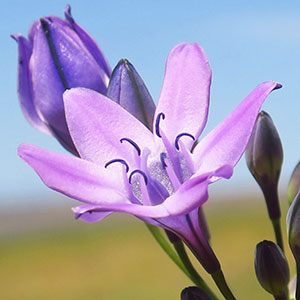Triteleia grandiflora
Triteleia bridgesii
blue umber-lily, blue-lily, Douglas' brodiaea, Howell's triteleia, large-flower triteleia, large-flower tritelia, wild hyacinth
Bridges' brodiaea, Bridges' triteleia
20–70 cm × 4–10 mm.
20–55 cm × 3–10 mm.
20–75 cm, smooth.
10–60 cm, smooth except sometimes scabrous near base.
perianth bluish purple to white, 17–35 mm, tube obtuse and rounded at base, 8–20 mm, lobes spreading, 9–13 mm;
stamens attached alternately at 2 levels, unequal;
filaments slender and somewhat triangular, wider toward base, or broad, 1–4 mm, apical appendages absent or present;
anthers yellow or purple, 2–4 mm;
ovary twice as long as stipe;
pedicel 1–4 cm.
perianth lilac, bluish purple, pink, or reddish purple, 27–45 mm, tube strongly attenuate with slender base, 17–25 mm, hyaline vescicles present in tube, lobes abruptly spreading, 10–20 mm, shorter than tube;
stamens attached at 1 level, equal;
filaments triangular, widened toward base, 3–4 mm, apical appendages absent;
anthers bluish, 3.5–4.5 mm;
ovary 1/4–1/3 length of stipe;
pedicel 2–9 cm.
= 16, 24, 32, 40, 48, 56.
= 16.
Triteleia grandiflora
Triteleia bridgesii
Triteleia grandiflora is the type species of the genus and, along with T. hyacinthina, is its most widely distributed member. Found throughout the region between the Cascade Range and the northern Rocky Mountains, in sagebrush steppe and adjacent woodlands, it is easily recognized by the shape of the perianth, which is rounded at the base instead of tapered as in other Triteleia species.
M. E. Barkworth (1975, 1977) studied variation within Triteleia grandiflora in relation to ploidy level. Polyploid plants are larger, flower later, and have more effective vegetative reproduction by cormlets and contractile roots than their diploid progenitors.
Plants of Triteleia grandiflora from the area west of the Cascade Range and extending into the Columbia River valley and the Klamath Lake region that have been distinguished as var. howellii differ from others of the species only in the shape of the filaments. L. Abrams and R. S. Ferris (1923–1960, vol. 1) used relative perianth length as a key character, but this is not consistent (R. F. Hoover 1941), and several specimens from the part of the Columbia River valley where both filament morphologies occur appear to represent intergrades (R. F. Hoover 1955). Thus it seems inadvisable to recognize infraspecific taxa. Plants assignable to var. howellii have not been found in California or southwestern Oregon in recent decades, and may be extirpated there.
Triteleia bicolor is merely a color form having a perianth with a blue tube and white lobe.
(Discussion copyrighted by Flora of North America; reprinted with permission.)
Triteleia bridgesii is similar to T. laxa and in herbarium specimens can be distinguished only by the stamens. However, in fresh flowers, the perianth lobes of T. bridgesii spread abruptly from the throat of the perianth tube, unlike those of T. laxa, and the flowers of T. bridgesii are erect, while those of T. laxa are oriented horizontally. Triteleia bridgesii flowers a month earlier than T. laxa where they both occur in the Sierra Nevada foothills. The flowers in specimens of T. bridgesii from Humboldt County are unusually long, which accounts for the wide ranges of measurements for the perianth.
(Discussion copyrighted by Flora of North America; reprinted with permission.)
- Local floras:
BC,
CA,
OR,
WA
- Local Web sites:
CalFlora,
CalPhotos,
Flora NW,
PNW Herbaria
WildflowerSearch
iNaturalist (observations)
USDA Plants Database
- LBJ Wildflower Center
- SEINet
- Plants of the World Online
- Encyclopedia of Life
- Wikipedia
- Google Image Search


